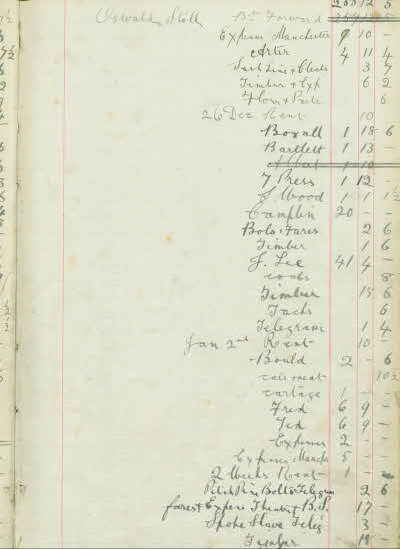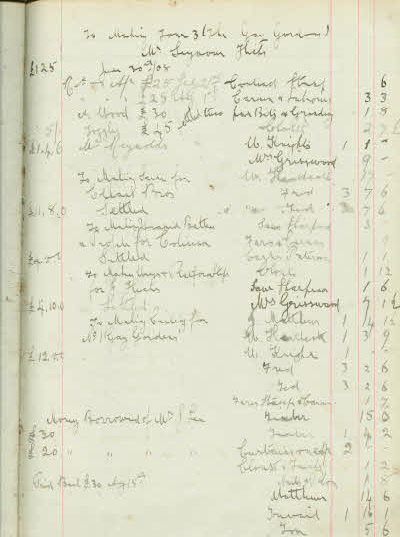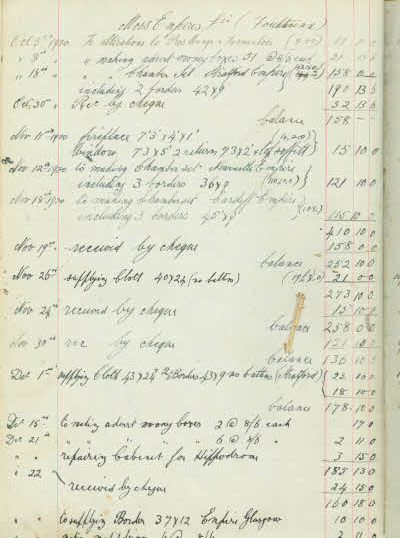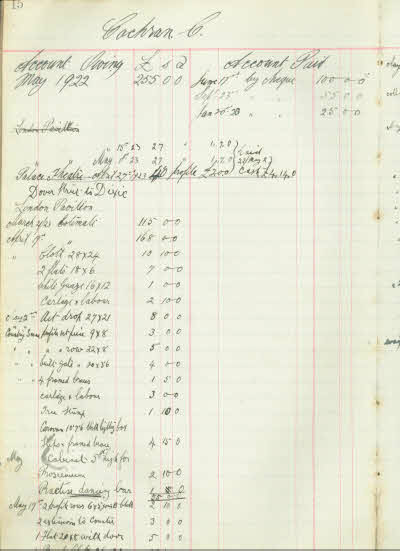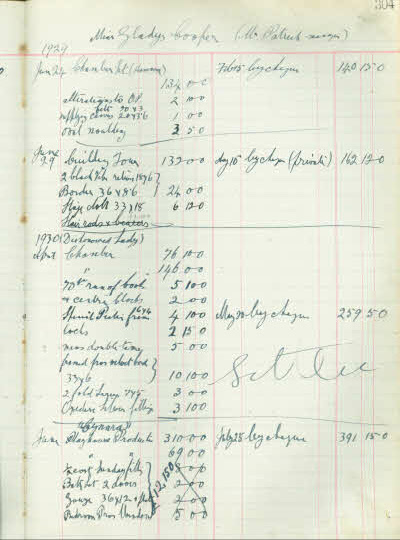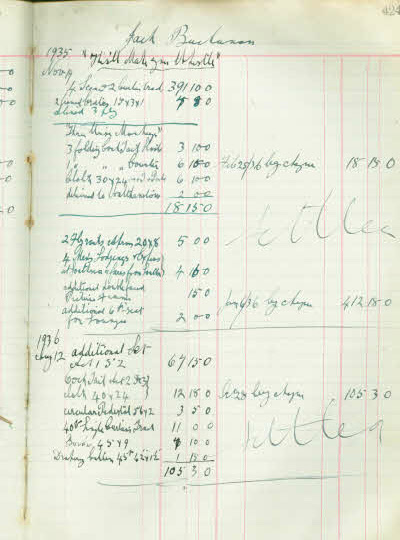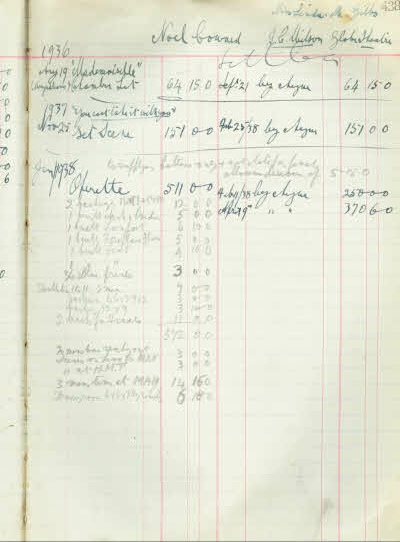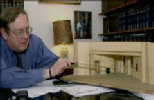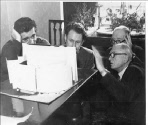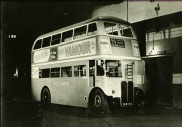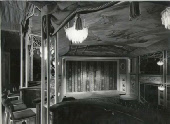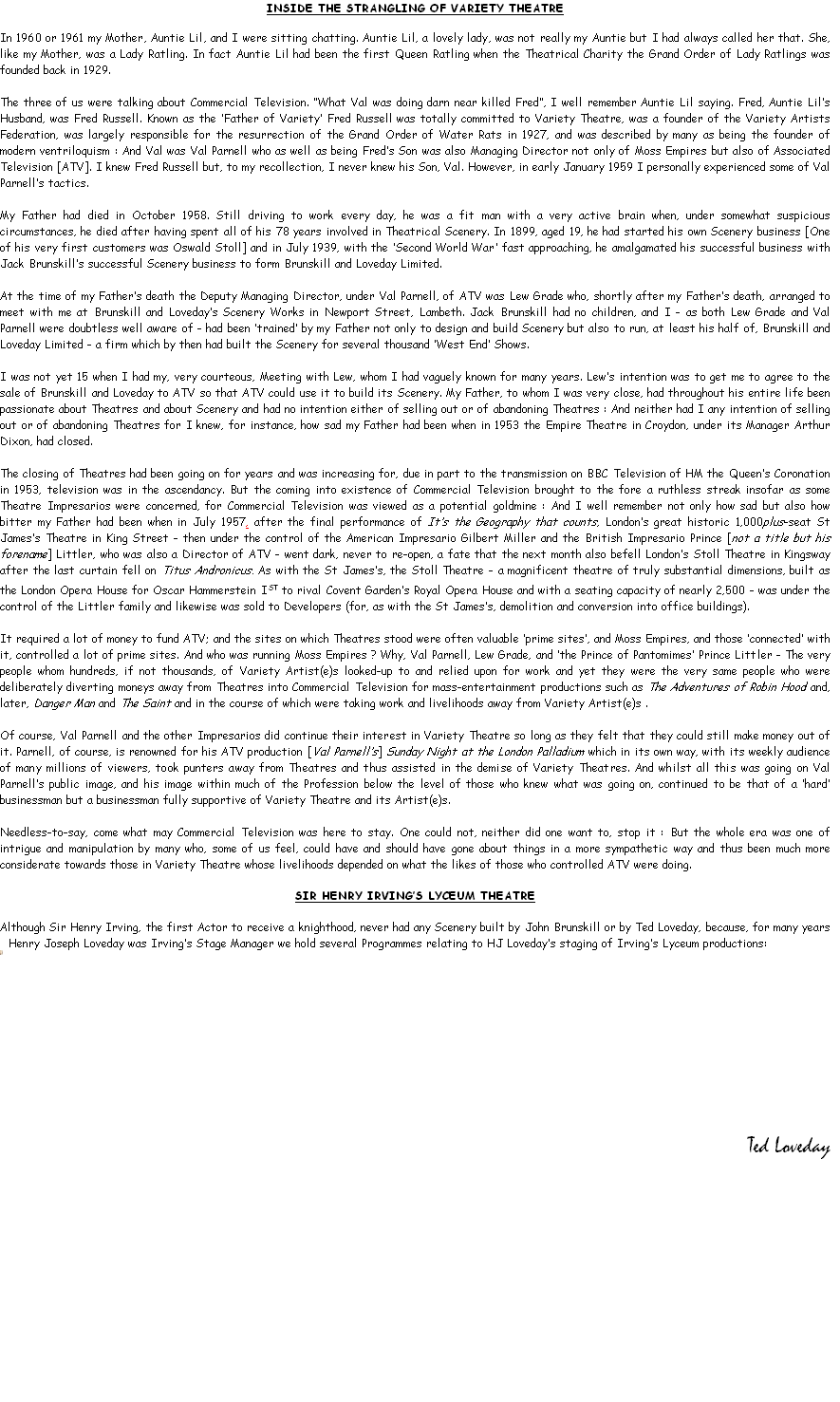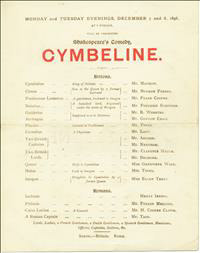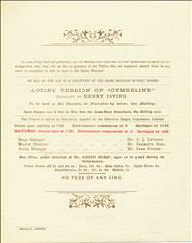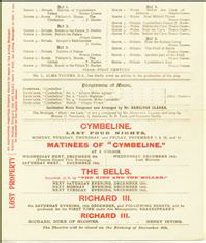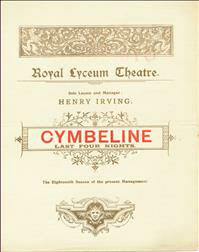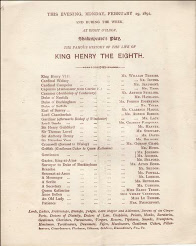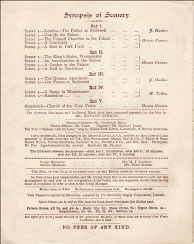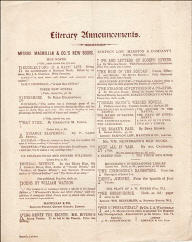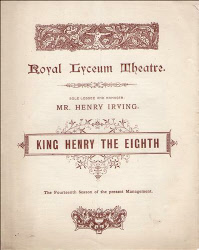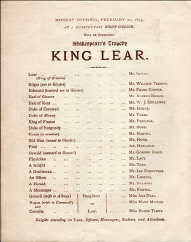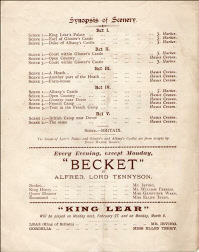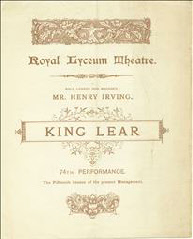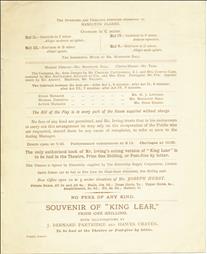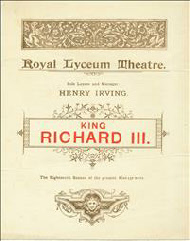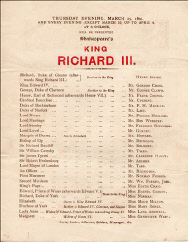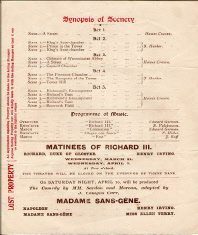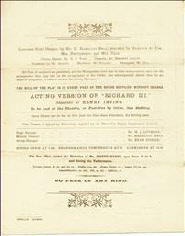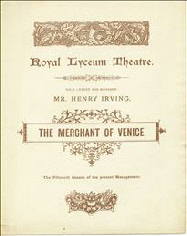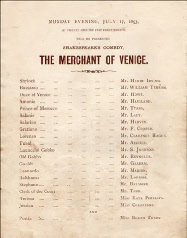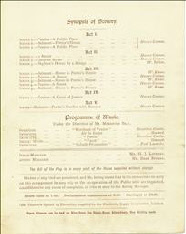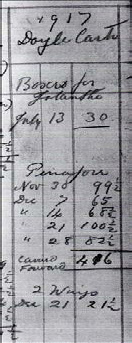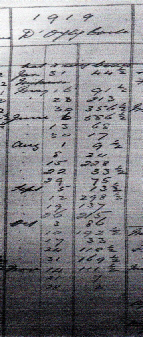5. Part of the account for the Actress and Theatre Manager GLADYS COOPER’s 1920 Production of ‘The Sacred Flame’ at London’s Playhouse Theatre, of the account for her Touring version of ‘The Sacred Flame’, of the account for her 1930 Production of ‘The Dishonoured Lady’ at London’s Playhouse Theatre, and of her account for her 1930 Production of ‘Cynara’ also at London’s Playhouse Theatre.
© Please note that our Archive is a private Archive, that this website and its contents are copyright, and that it is unlawful for the whole of this website or any part of this website to be in any way, directly or indirectly, reproduced, transmitted, and/or stored in any form, including pictorial, without the prior written consent of a Director of Brunskill and Loveday Limited having been obtained. However, if you wish to link to the entirety of this website from your own website please feel free to do so - but on the condition that you e-mail us immediately that you have done so to let us know.
______________________________________________________________________
Dear Visitor
Despite the fact that many Actors, Actresses, and other Performers have received much recognition over the years Theatrical Scenery - which includes drapes (curtains) and which often plays a major part in an Audience’s enjoyment of a Show or Performance - has, more often than not, been forgotten, or almost forgotten, about. We believe that any true understanding of the history and development of UK Theatre must also include a depth of knowledge of the history and development of other facets of UK Theatre of which Theatrical Scenery is certainly one. Hence, as our humble attempt to at least partly rectify the situation, this website. So, welcome to the world of well in excess of 5,000 Shows for which the Scenery was built by Brunskill and Loveday Limited, arguably one of the most successful of 20th century UK Scenery-building firms. [There are over 25,000 entries in the databases.]
IF YOU WISH TO KNOW ABOUT THE ORIGINS OF BRUNSKILL AND LOVEDAY LIMITED, please read
on:
First registered as a limited company on 26 July 1939 Brunskill and Loveday Limited
was formed by the amalgamation of two, by then, well-established, and very successful,
Scenery-building firms - John Brunskill Limited and Loveday & Higson. With the 'Second
World War' almost about to start the two firms, previously each often the other's
principal (but friendly and, at times, very co-operative) competitor, came to-gether
because each felt that they would have a better chance of economically surviving
the War as one unit than as two competing units.
The success of the two businesses which gave birth to Brunskill and Loveday Limited
was principally due to three people - John Brunskill, Edwin [Ted] George Loveday,
and John [Jack] Higson.
John Brunskill, the founder of John Brunskill Limited, was born in Penge, London
in 1870 to William Brunskill a Carpenter/Joiner who was born in Melmerby, Cumberland
(now part of Cumbria) in 1836 and who became the Master Carpenter in London's Empire
Theatre. When a boy John Brunskill went to work for the Impresario Richard D'Oyly
Carte as a trainee Stage Carpenter on original productions of Gilbert and Sullivan's
Comic Operas in Carte's then newly built Savoy Theatre. After having learned the
skills necessary to enable him to become a Theatre Master Carpenter he, assisted
by the D’Oyly Carte Family, branched out as a builder of Scenery on his own account
and built the Scenery for D’Oyly Carte’s Gilbert and Sullivan ‘Savoy Operas’; and
by 1927, so the London Evening News informed its readers in August of that year,
he had "been making scenery for London and provincial theatres for a quarter of a
century". By then John Brunskill was in a partnership, but still trading as John
Brunskill, with his Son, John [Jack] Robert Brunskill, and with another Scenery builder,
HP Flack. The business was incorporated as John Brunskill Limited in 1931.
Ted Loveday (my Father) was born in Aylesford Street, Pimlico, London in 1880. Charles,
his Father (my Grandfather), was a Musician, and one of my Grandfather's brothers,
Henry Joseph [HJ] Loveday, was also a Musician who, when aged only 19, was appointed
Conductor of the Orchestra in Edinburgh's Theatre Royal. In 1877 HJ Loveday became
Stage Manager, Adviser, and friend to the Actor-Manager Sir Henry Irving at Irving's
Lyceum Theatre off London's Strand. [They first met when Irving was appearing in
Edinburgh between 1857-1860], He remained as Irving's Stage Manager, Adviser, and
friend until Irving's death in 1905. [Their Assistant at the Lyceum Theatre was Bram
Stoker, the author of 'Dracula' (a story doubtless much influenced by Irving and
the dark, draughty, creepy eeriness of life, as it then was, backstage at the Lyceum).]
Another of my Father's Uncles was George Beaumont Loveday, a Manager of Theatres
and of Artists [including the then very famous comic Actor (and Producer) John Lawrence
Toole] and an Impresario for whom, in 1883, Eastbourne's Theatre Royal [now known
as The Royal Hippodrome] was built. [Their Grandfather was an Actor at The Theatre
Royal, Covent Garden in the days of the Kembles. Their Father, William Loveday, was
an Actor at The Theatre Royal, Drury Lane with Edmund Kean and their Mother was an
Actress with Kean.] In his early teenage years my Father became proficient in the
crafts of Joinery and of Cabinet-making before, in 1899 when aged 19, starting his
own Scenery-building business [One of his first customers being the Impresario Sir
Oswald Stoll for whom my Father, when aged 24, built much of the Scenery for Stoll’s
opening Production at his brand new London Coliseum Theatre (of Varieties)].
Jack Higson was the eldest of the three. When aged only 11, he was already in paid
work doing all sorts of 'behind the scenes' jobs in professional Theatre before becoming
first a trainee Stage Carpenter, then a Stage Carpenter, then a Theatre Master Carpenter.
Thereafter he became Technical Advisor to such Theatrical 'greats' as the Impresario
Sir Charles Blake [CB] Cochran. Jack Higson's technical knowledge of Scenery, of
Stage Construction, and of Stage Mechanics [traps, revolves, ascending and descending
Scenery, etc] was considered to be of the finest quality. He also built Scenery on
his own account and continued to do so until 1922.
------
Public radio broadcasting did not commence in the UK until the early 1920s [several
years before Television] and therefore, although increasing numbers of Cinemas were
coming into existence, Music Halls and Theatres were the principal places where large
numbers of people went to be entertained. Most towns, even many villages, had at
least one Music Hall and/or one Theatre, and many large towns and cities had several
of them [see, for instance, the website of Arthur Lloyd for further information].
Therefore, given, due to its many Music Halls and Theatres, the considerable amount
of Scenery that was required in the London area in the early years of the 20th century,
there were in London many Scenery builders some of whom - such as Bruce Smith, Francis
Bull, George Hemsley - made Scenery in conjunction with, or which they sub-contracted
to, John Brunskill, Ted Loveday, and/or Jack Higson (the sub-contractors sometimes
receiving no public acknowledgement whatsoever, even if they actually built all the
Scenery for the entire Show).
John Brunskill, Ted Loveday, and Jack Higson had advantages over many other Scenery
builders for each had [1] been born into a family deeply involved in professional
Theatre with a bias towards Scenery, [2] been brought-up surrounded by very 'useful'
influential theatrical 'contacts', and [3] in his childhood learned in great practical
detail the art and skills needed to, almost entirely by hand in those days, construct
Scenery. Also, not only in the 1890s was flat Perspective Scenery (cloths, etc, with
walls, ceilings, doors, windows, and so on painted on them) beginning to be replaced
by Realistic Scenery (actual walls and ceilings, real doors and windows that actually
opened and closed, and so on) but in the 1900s the trend of sending 'London' Shows
touring around the UK had begun to seriously evolve : And sending Shows around the
UK involved not, as is now usually the case, just a handful or so of Theatres but
sometimes scores, if not hundreds, of Theatres (see the Database), the Scenery being
transported around the landmasses of Great Britain and Ireland either over, often
very poor by to-day's standards, roads in lorries (sometimes in excess of 20 lorries,
some with one or more trailers, per Show) or transported from railway station to
railway station in carriages (occasionally as many as 8 or more per Show) especially
made/adapted for Scenery by the railway companies of the day. [In London Scenery,
of lengths at times in excess of 30ft (9.14M), was sometimes trundled through the,
often very crowded and tram-track grooved, streets on 2-wheeled handcarts, the 'made
to last' sturdily-built Scenery having been stacked on board the handcarts by the
several men and boys who to-gether pushed, pulled, shoved, and manoeuvred the carts
over the setted, stoned, and/or tarmacked streets.]
------
John Brunskill operated his business out of premises in Newport Street in Lambeth,
South London and my Father operated his business out of premises sited almost next
to The Oval Cricket Ground in Kennington Green, also in Lambeth, the one business
being just a few minutes' walk away from the other. [In 2004 I asked the Theatrical
profession's much respected former maker of Stage Props, Jack Lovell, what was so
special about Lambeth. Then aged 92 but still very mentally alert, Jack, who had
known my Father well, informed me that "in those days" Lambeth (including Brixton
and Kennington) abounded with highly skilled Theatrical trades- and craftspeople,
many of whom operated as one-, two-, or three-person businesses and that therefore,
what was in effect, a unique 'production line' culture existed in Lambeth which,
whenever called upon to do so, could instantly feed skills and products into assisting
the Scenery Contractors so that the Contractors could immediately respond to the
demands of Impresarios and others who required Scenery, often large quantities of
it, to be built and delivered within a matter of days if not, as sometimes happened,
within hours.]
The third member of the trio, Jack Higson, although very knowledgeable insofar as
the mechanics of Theatres and the construction of Scenery were concerned, was not
the best insofar as the running of a business was concerned and by 1921 his business
was, 'paperworkwise', struggling : And so, in 1922, my Father - out of gratitude
for the many instances of technical assistance that Jack Higson had given to him
over many years [and doubtless with a desire to have Jack Higson's technical skills
and knowledge within his own business] - amalgamated his successful and very profitable
business with Jack Higson's successful but not very profitable business. Thus Loveday
& Higson was formed and continued beyond Jack Higson's death in the 1930s until 1939
when Loveday & Higson amalgamated with John Brunskill Limited [then being run by
John Brunskill's Son, Jack, following John Brunskill's death in August 1933] to form
Brunskill and Loveday Limited. [My Father died in October 1958 and Jack Brunskill
died in November 1977.
*****
Much of the information in this website's Database - which is an ongoing undertaking
- originates from account books held by us which were handwritten in times, commencing
over 100 years ago, long before computers came into existence and in an age when
accounting procedures were somewhat 'skeletal' compared with to-day's accounting
procedures. Those account books held by us remain private but we reproduce the following
7 pages by way of illustration:
IF YOU WISH TO NOW GO TO THE DATABASES (1) OF SHOWS FOR WHICH BRUNSKILL AND/OR LOVEDAY
BUILT ALL OR PART OF THE SCENERY AND (2) OF SOME OF THE THEATRES INTO WHICH THOSE
SHOWS WENT [1] go to the MAIN MENU on the left and then [2] click on DATABASE OF
SHOWS AND THEATRES.
1. Part of the 1903-04 account for the Theatre Manager and Impresario OSWALD STOLL
for a Show staged in Manchester. [Unfortunately we have as yet been unable to work
out either the name of the Show or the name of the Theatre(s) in which the Show was
staged (Perhaps a Visitor to this website knows and can tell us ?)].
2. Part of the account for the Actor, Playwright, Producer, and Impresario SEYMOUR HICK’s Nos.1 and 3 Touring Shows of his 1907 Production of ‘The Gay Gordons’ at London’s Aldwych Theatre.
3. Part of the account for MOSS EMPIRES in respect of work done for Shows in or going
into The Empire Theatre, Stratford (East London); The Empire Theatre, Newcastle upon
Tyne; The Empire Theatre, Cardiff; The London Hippodrome; and The Empire Theatre,
Glasgow, all during October to December 1920.
4. Part of the account for the Actor, Agent, and Impresario CHARLES BLAKE (CB) COCHRAN’s 1923 Production of ‘Dover Street to Dixie’ at London’s Pavilion Theatre.
6. Part of the account for the Actor, Singer, Dancer, Director, and Manager JACK
BUCHANAN's 1936 Production [tried out first at the King's Theatre, Southsea in 1935]
of 'This'll make you whistle' at London's Palace Theatre, and for an additional Set
made in 1936 for the Show's Touring version.
7. Part of the account for the Actor, Singer, Playwright, Composer, Producer, and
Impresario NOEL COWARD's 1936 Production of 'Mademoiselle' at London's Wyndham's
Theatre, of the account for his 1937 Production of 'You can't take it with you' at
London's St James's Theatre, and of the account for his 1938 Production of 'Operette'
at London's His Majesty's Theatre.
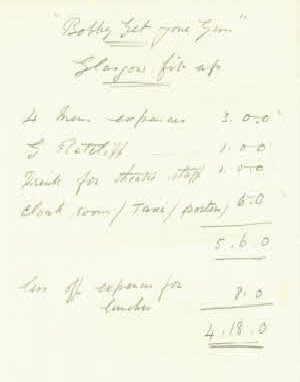
Scenery Contractors not only 'churned out' Scenery. Their skills and knowledge were
such that they advised many a Scenery Designer on what, technically, was or was not
possible, and their Staffs were often required to travel far and wide to erect the
Scenery that they had built, to advise and instruct others on how to erect and service
it, and so on. By way of an example, above is a copy of a handwritten costing note
held by us within the account file for the Producer, Composer, Lyricist JACK WALLER's
1938 Production of 'Bobby Get your Gun'. The Scenery for the Show, which went into
London's Adelphi Theatre, cost Jack Waller £981/16/0 [£981.80p] (equivalent to about
£240,000 to-day). Before it went into The Adelphi the Show had a 3-weeks' preliminary
run at The Alhambra Theatre in Glasgow; and one of Jack Waller's requirements, and
at a separate cost to Jack Waller of £4.18.0 [£4.90] (circa £1,200), was that 5 members
of Loveday and Higson's Staff had to travel the 400 miles or so from the Scenery
Works in Kennington to Glasgow to advise on, and help undertake, the Show's fit-up
[and to buy drinks for the Theatre's Staff !!].
Almost anyone nowadays can take photographs and reproduce them by means such as downloading
them from a digital camera into a computer from whence, via a connected printing
facility, any number of reproductions can be printed off : But throughout much of
the first half of the 20th century the taking and reproducing of photographs was
somewhat of a difficult technical undertaking and thus often the province of Specialists.
One of the ‘great’ Theatrical publications of the first half of the 20th century
was The Play Pictorial, a monthly magazine which specialised in publishing photographs
of many of the Shows which went into London’s ‘West End’. My Father and John Brunskill
were very early subscribers and they relied upon The Play Pictorial [which incorporated
‘The Play’, ‘The Play Souvenir’, and ‘Plays and Players’ before itself being incorporated
into the (British not American) ‘Theatre World’ publication] to provide them with
a photographic record of many of the ‘West End’ Shows for which they built the Scenery.
Our Library of Play Pictorials, which commences with Volume 1 Number 1, has thus
played a major part in enabling us to reproduce, via the ‘PHOTO’ column on this website’s
Database, photographs of some of the Scenery built by Brunskill and/or Loveday and/or
Higson for Shows that were staged in London’s ‘West End’. [We apologise for the poor
quality (compared with to-day’s standards) of some of the reproduced photographs.]
We hope that you enjoy reading this website and that you find our Database of 'Brunskill
and Loveday Shows', and the Theatres that the Shows went into, to be interesting
and informative. Our Database is an ongoing undertaking and, in compiling it, we
are endeavouring to be as accurate as possible; but doubtless the Database does contain
errors, omissions, etc. These we have sought to keep to a minimum by checking our
information against information within such as [1] JP Wearing's splendid 16-volume
book The London Stage and [2] The Stage newspaper's superb Archive the invaluable
assistance of which has enabled us to substantially widen the knowledge that we had
of the Theatres that many of the Touring Shows went into. Also, we have been assisted
by gratefully-received information given to me by the Brunskill Family, principally
by the Architect John Burkett, Jack Brunskill's Nephew-in-law (who knew Jack well
for many years). We are also grateful for the detailed firsthand knowledge imparted
to me by the Properties Maker Jack Lovell (who knew my Father well for many years)
and for information given to me by the, now no longer, Tableau Lodge [a Masonic Lodge
founded in 1927 by John Brunskill and my Father along with other Theatricals involved
in the Scenery side of the Profession (namely Albert E Wood, Master Carpenter at
London's Royalty Theatre; Phillip Sheridan, Director of the Theatrical Lighting firm
Strand Electric; William H Davies, Master Carpenter at London's Wyndham's Theatre;
Francis L Lyndhurst, Scenic Artist; Lionel W Arter, specialist Supplier of timber
for Theatrical Scenery; H Hunt, Master Electrician at London's Daly's Theatre; Reginald
Holt, Property Master and Master Carpenter at London's Aldwych Theatre; Charles J
Cheeseman, Scenery Contractor; F Maurice Wilson, Scenery Contractor; Arthur T Earnshaw,
joint-Founder of Strand Electric; Wallace C Saunders, Master Electrician at London's
Kingsway Theatre; FC Hinton, Box Office Manager at London's Lyric Theatre; Harry
D Marsh, Senior Theatre Electrician; John FP Hill, Master Carpenter at London's Daly's
Theatre; Robert Smith, Stage Manager at the London Palladium Theatre; A Stapley,
Stage Manager at the London Hippodrome Theatre; James Frazer, Scenic Artist; and
H Flack, Scenery Contractor)]. Above all, I personally am hugely indebted to my late
Father for imparting to me a wealth of information about the origins of Brunskill
and Loveday Limited and its personalities; about the many customers, friends, and
other Theatricals with which it and its predecessor businesses were involved; and
about the thousands of Shows for which, during the 20th century, he, John and Jack
Brunskill, and Jack Higson built, or in conjunction with other Scenery Contractors
built, the Scenery.
Enjoy ....and be entertained !!
Ted Loveday
Managing Director
Brunskill and Loveday Limited
PS We regret that we are unable to assist people who ask us if we would/could let
them know, for instance, whether or not their grandmother appeared in the Chorus
Line in such-and-such a Show in Glasgow in the 1930s or whether their great grandfather
ever owned or part-owned such-and-such a Music Hall in South London in about 1897
or what was the real name of someone who appeared under such-and-such a Stage name
back in the 1920s. Sorry !!
The original of this Website ‘went public’ on 22 July 2009

The Archive of 20th century Theatrical Scenery built by
BRUNSKILL & LOVEDAY LIMITED
Registered Office: 55-57 Bridge Street . Berwick-upon-Tweed TD15 1ES e-mail:
theatrical-scenery@tiscali.co.uk [If writing to us, e-mail correspondence is preferred.
Otherwise a suitably stamped addressed envelope must be enclosed if you wish us to
reply.]
Member of APAC [the Association of Performing Arts Collections
(www.performingartscollections.org.uk)]
Member of APAC [the Association of Performing Arts Collections]
with access to well over 6,500 Programme Fronts as well as access to thousands of
Cast Lists and other pages from all of the London Programmes and from hundreds of
the Provincial and other Programmes and also access to some Photographs of Scenery
on Stage.
John Brunskill on his way to work in the 1920s.
Discussing a Set for the 1953 Production of Dangerous Curves - The Producer, Director,
and Actor Terence de Marney; The Designer Guy Sheppard; The Scenic Artist Phil Harker;
and my Father Ted Loveday.
Jack Higson on a Works Outing in the 1930s.
The Writer of this Home Page demonstrating, in 2007, the Sightlines and technical
construction of a Set that he had designed.
Jack Brunskill in his Drawing Office in the late 1940s.
An almost full-size replica of a London Transport ‘bus built to go, full of passengers,
on the revolving Stage of London’s Coliseum Theatre for the Opening Scene (“London
Town”) of the 1949 Royal Variety Show [Royal Command Performance]. (An actual ‘bus
would have been just a wee bit too big to get into the Theatre and a bit too heavy
for the Stage !!)
The Riverside Theatre in London’s Battersea Park. Designed by the Set Designer Guy
Sheppard as part of the Labour Government’s Festival of Britain Exhibition and part-built
by Brunskill and Loveday, it opened in May 1951, had 368 seats, was fully equipped,
and had 19 sets of Lines. Intended that it be in existence for many years, 5 months
later, in October 1951, the newly elected Conservative Government ordered the closure,
demolition, and removal of Battersea’s Festival of Britain site including the Riverside
Theatre !!
For further information about Brunskill and Loveday, about Variety Theatre, Impresarios and so on go to the British Library’s Theatre Archive website at http://sounds.bl.uk and type loveday in the Enter keywords box.
Also, you might find the following article, INSIDE THE STRANGLING OF VARIETY THEATRE, interesting. It was published in the Summer 2012 edition of the British Music Hall Society’s Call Boy magazine.
Copyright © 5 January 2019 Brunskill and Loveday Ltd Websiite
layout designed by Brunskill and Loveday Ltd
Ted Loveday
Managing Director
Brunskill and Loveday Limited


